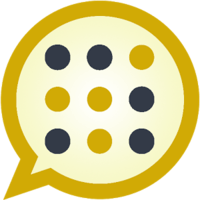MessagEase
MessagEase is an input method and virtual keyboard for touchscreen devices. It relies on a new entry system designed by Saied B. Nesbat, formatted as a 3x3 matrix keypad where users may press or swipe up, down, left, right, or diagonally to access all keys and symbols.[1] It is a keyboard that was designed for devices like cell phones, mimicking the early cell phones' limited number of 12 keys.[2]

The most common letters (the large letters in the illustration below) are accessed by a tap. Less common letters are accessed by a slide. Example: Tapping the center square generates an 'o'. Sliding to the left from the same square generates a 'c'. A green trail shows the path of the finger.[3] The keyboard supports multiple user dictionaries, used for word prediction and correction.[4]
The software is developed and patented by ExIdeas, based in Belmont, California. It was first released in 2002 for the Palm, along with a paper in 2003.[5]
Layout

The keyboard layout has a 3x3 matrix that allows for full-text entry. The letter placement is optimized for minimal movement distance between letters, allowing for faster typing.[6]
The layout is 67% faster than a standard QWERTY software keyboard, and 31% faster than a multi-tap keyboard, when typing is modeled with Fitt's law.
One touch keys
The 9 most frequent letters in English texts: ETAONRISH, are placed on the keyboard so they can be accessed on a single click.
One move keys
The next 17 less frequent letters: DLFCMUGYPWBVKJXQZ, are placed as to be triggered by a single move of the finger from or to the central key (O) (except for Z which is centered around the 'E' key together with some punctuation characters). For example, the letter V is typed by dragging the finger from A to O, and the letter D by moving from O to E.
Special characters
The moves producing special characters, which includes 38 characters including accents and punctuation marks, are displayed on a complete keyboard showing up when the user drags the space bar upwards.
This is not an alternate keyboard in the sense that the key pair moves are valid on both keyboard. It is rather a mnemonic help, which is normally hidden to avoid overwhelming the user with spurious information.
Control keys
A small vertical bar on the right (or on the left in left-handed mode) gives direct access to the cut/copy/paste operations, the numeric keypad, the uppercase/lowercase control, as well the usual F1-F12 control keys. This is also commanded by moving the finger from one cell to an other.
Semantic sugar
A set of small movements makes the life of the typist easier, like drawing a small circle or a back and forth movement to write a letter uppercase, or prolonging the movement to put accent on letters.
The keyboard can be resized to fit the need of the user, and is also provided in a double sized version with the numeric keypad on the side of the alphabetic keypad[7].
Software
The keyboard is currently available for Android devices, iOS devices and the Apple Watch.[8]
Currently supported input languages:
History
MessagEase was released in 2002 for the Palm. It was also originally a competitor to the T9 predictive input method, on a 12-button phone, with 9 number buttons. In this first iteration, each of the 9 primary characters needed to be pressed twice in a row, and secondary characters were entered by first pressing the main button, and then pressing one of the remaining 8 buttons.[9] In this first iteration, because many letters required two presses, it was not significantly faster than the Multi-tap input method.[10]
MessagEase is now exclusively for touch screens, and no longer has physical 12-button support. All characters are now entered by tapping or swiping.
References
- Bozorgui-Nesbat, Saied (2003). "A system for fast, full-text entry for small electronic devices". Proceedings of the 5th International Conference on Multimodal Interfaces - ICMI 2003. Vancouver, British Columbia, Canada: ACM Press. pp. 4–11. ISBN 1-58113-621-8.
- Khalil Ibrahim, Ismail (30 September 2008). Handbook of Research on Mobile Multimedia (Second ed.). Information Science Reference. p. 777. ISBN 978-1605660462.
- "Four funky Android keyboards". Retrieved 27 December 2015.
- "Android FAQ". Retrieved 19 March 2015.
- Lomas. "As Mobile Devices Morph Into Wearables, Keyboard Maker MessagEase Wants Your Fingers To Settle On Its Qwerty Killer". TechCrunch.
- Bozorgui-Nesbat, Saied (2003). "A system for fast, full-text entry for small electronic devices". Proceedings of the 5th International Conference on Multimodal Interfaces - ICMI 2003. Vancouver, British Columbia, Canada: ACM Press. pp. 4–11. ISBN 1-58113-621-8.
- Alkhalifa, Eshaa (31 May 2012). Cognitively Informed Intelligent Interfaces: Systems Design and Development (1st ed.). IGI Global. p. 30. ISBN 978-1466616288.
- "MessageEase". Retrieved 19 March 2015.
- Paternò, Fabio, ed. (2002). Mobile Human-Computer Interaction - 4th International Symposium - Mobile HCI 2002. Pisa, Italy: Springer. p. 208. ISBN 3-540-44189-1.
- Chi Connect 2004: Conference Proceedings: Conference On Human Factors In Computing Systems. Vienna, Austria: ACM Press. April 2004. p. 352. ISBN 978-1581137026.